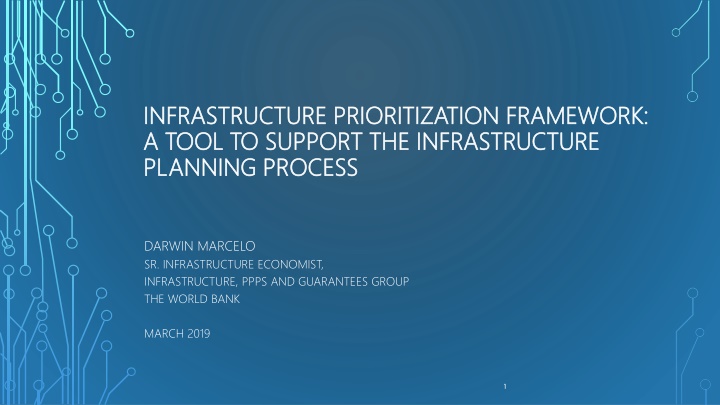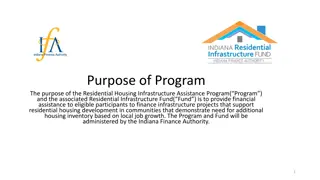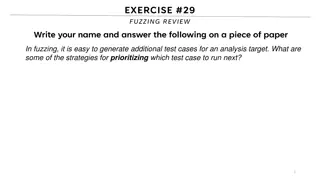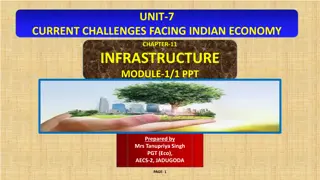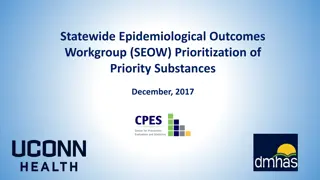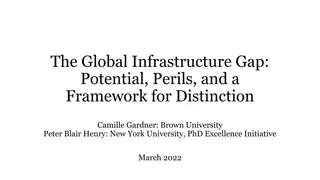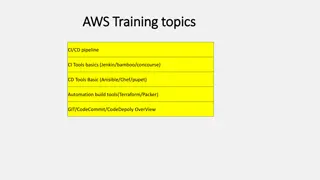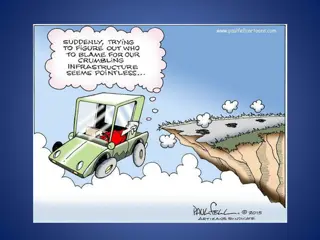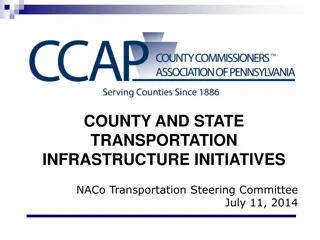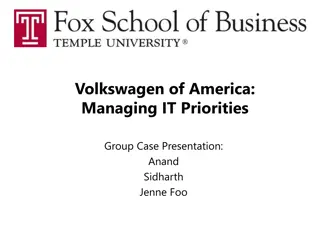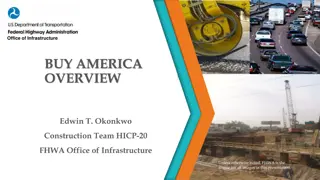Infrastructure Prioritization Framework and Challenges
The Infrastructure Prioritization Framework (IPF) is a tool designed to support the infrastructure planning process, aiming to address challenges such as infrastructure gaps, limited resources, and technical capacity constraints. The tool integrates social, environmental, and financial criteria to help prioritize infrastructure investments in line with strategic priorities. Challenges include data availability issues, institutional capacity constraints, and the need for objective systems to assess infrastructure projects effectively.
Download Presentation

Please find below an Image/Link to download the presentation.
The content on the website is provided AS IS for your information and personal use only. It may not be sold, licensed, or shared on other websites without obtaining consent from the author.If you encounter any issues during the download, it is possible that the publisher has removed the file from their server.
You are allowed to download the files provided on this website for personal or commercial use, subject to the condition that they are used lawfully. All files are the property of their respective owners.
The content on the website is provided AS IS for your information and personal use only. It may not be sold, licensed, or shared on other websites without obtaining consent from the author.
E N D
Presentation Transcript
INFRASTRUCTURE PRIORITIZATION FRAMEWORK: INFRASTRUCTURE PRIORITIZATION FRAMEWORK: A TOOL TO SUPPORT THE INFRASTRUCTURE A TOOL TO SUPPORT THE INFRASTRUCTURE PLANNING PROCESS PLANNING PROCESS DARWIN MARCELO SR. INFRASTRUCTURE ECONOMIST, INFRASTRUCTURE, PPPS AND GUARANTEES GROUP THE WORLD BANK MARCH 2019 1
INFRASTRUCTURE PRIORITIZATION CHALLENGE (1/1) INFRASTRUCTURE PRIORITIZATION CHALLENGE (1/1) Infrastructure gap and demands on governments Infrastructure gap and demands on governments Investment needs in all sectors Limited public resources and fiscal restrictions Strengthening fiscal transparency and accountability How to optimize public resources in line with country strategic priorities? How to compare different investment options? Need Need for for an an objective objective system system to to prioritize prioritize infrastructure infrastructure investments investments 2
INFRASTRUCTURE PRIORITIZATION CHALLENGE (1/2) INFRASTRUCTURE PRIORITIZATION CHALLENGE (1/2) Technical Capacity and Measurement Technical Capacity and Measurement Limited / inconsistent project data availability & quality Limited technical and institutional capacity High costs and extensive time to run SCBA across large sets of projects For CBAs-based analyses capturing key policy goals (e.g. culture heritage, climate resilience, job creation, poverty reduction) is more difficult. Public investments produce benefits that cannot be monetized Need Need for for an an objective objective system system to to prioritize prioritize infrastructure infrastructure investments investments 3
INFRASTRUCTURE PRIORITIZATION FRAMEWORK INFRASTRUCTURE PRIORITIZATION FRAMEWORK IPF, a Multi IPF, a Multi- -Criteria Decision Tool Criteria Decision Tool Can be adapted to account for policy goals Combines social social- -environmental environmental and financial Accommodates to data data and resource limitations policy goals* financial- -economic resource limitations economic information Includes the sector budget constraint Displays information in a simple visual interface Improves data collection processes* budget constraint visual interface 4
IPF AS A STEPPING STONE IPF AS A STEPPING STONE Selection informed Selection informed by full SCBA by full SCBA Selection by IPF Selection by IPF Limited institutional and/or technical capacity Assumes partial project-level information available Including information on social, environmental, other economic effects Decisions based on minimum relevant information Ad Ad- -Hoc project Hoc project selection selection High technical and institutional capacity Detailed project-level information available Requires monetized social, environmental, financial and economic effects Selection based on NPV comparison Limited project-level information available Inconsistent use of information Decisions frequently based on non-technical or political considerations Subjective project selection 5
THE IPF PROCESS THE IPF PROCESS Consensus between decision makers, experts, and key stakeholders I. Define Criteria Feedback Project-level database (including CBA elements when available) II. Prepare Data Includes statistical / mathematical methods to combine criteria into two composite indicators III. Calculate Composite Indicators Combine SEI, FEI, and budget constraint to visualize relative project performance IV. IPF Matrix V. Project Selection Based on informed deliberation 6
TWO TWO- -DIMENSIONAL STRUCTURE DIMENSIONAL STRUCTURE Social Social- -Environmental Indicator (SEI) Environmental Indicator (SEI) (example) (example) Financial Financial- -Economic Indicator (FEI) Economic Indicator (FEI) (example) (example) Beneficiaries* Affected population* Environmental effects* Poverty levels* Benefit-cost ratio* Multiplier effects* Externalities* Implementation risks* Fundable projects given the budget constraint Fundable projects given the budget constraint 7 7
PROJECT PRIORITIZATION MATRIX PROJECT PRIORITIZATION MATRIX 100 100 90 90 Y Y Z Z F F O O V V High Priority Projects 80 80 Social-Environmental Priority Projects K K D D 70 70 Fundable projects given budget constraint P P W W G G N N 60 60 Q Q B B 50 50 SEI SEI E E 40 40 A A I I Financial- Economic R R J J 30 30 Lower Priority Projects L L T T Priority Projects C C 20 20 X X S S 10 10 M M H H U U 0 0 0 0 10 10 20 20 30 30 40 40 50 50 60 60 70 70 80 80 90 90 100 100 FEI FEI Fundable projects given budget constraint 8
IPF EXCEL ADD IPF EXCEL ADD- -IN IN User-friendly Easy to input data and to use Flexible criteria adjustment multiple scenarios depending on policy objectives 9
IPF EVOLUTION IPF EVOLUTION Belarus Belarus Chile Chile Sri Lanka Sri Lanka Argentina Argentina Launching of the IPF Excel Add-In that automates the analytical process Panama Panama Comparison with CBA- based system to assess IPF suitability Qualitative data untransformed Novel constrained PCA (CPCA) approach Measure of efficiency to compare weighting scenarios Additional scenario based on pre-ordered criteria weights Vietnam Vietnam only one stage in a five-steps systematic process Sensitivity analysis on weights Two-stages process All qualitative criteria transformed into quantitative scales PCA-based criteria s weights 10
INFRASTRUCTURE PLANNING CYCLE AND INFRASTRUCTURE PLANNING CYCLE AND IMPLEMENTATION OF THE IPF IMPLEMENTATION OF THE IPF
INFRASTRUCTURE PLANNING PROCESS CYCLE INFRASTRUCTURE PLANNING PROCESS CYCLE Phase IV Phase IV Phase I Phase I Phase II Phase II Phase III Phase III National/ Regional/Sector/ Investment Plan Investment Needs Maximizing Finance for Development Project Preparation Information Consolidation Project Screening and Prioritization Identification of minimally relevant criteria Template for project applications Information System Identifying high priority infrastructure projects: Using cost-benefit or multi-criteria analysis (such as the IPF) Identifying optimal financing solutions for implementation: PPPs, ODA, Public Funds, SOEs, etc. In practice, national infrastructure planning processes tend to be more complex depending on the country regulation and institutional framework 12
IPF AS A PUBLIC INVESTMENT MANAGEMENT TOOL IPF AS A PUBLIC INVESTMENT MANAGEMENT TOOL IPF TOOL IPF TOOL Project appraisal and selection Support in decision- making for planning and allocation Coordination on data collection and project selection criteria 1 2 3 4 5 6 7 8 Implementation Independent Adjustment Evaluation Operation Guidance Appraisal Selection Review Link to developmen t strategy Consistency in project preparation Key to credible selection Authority to screen and reject proposals An effective budget and procurement process to support implementation and operation Maintain, asset register, operate and maintain asset Evaluation to improve guidance Source: Power of Public Investment Management (Rajaram et al., 2014) 13
IPF AND THE IPF AND THE INFRA PLANNING INFRA PLANNING CYCLE: THE CASE CYCLE: THE CASE OF SRI LANKA OF SRI LANKA Infrastructure Investment Planning Process in Sri Lanka IPF bridges the gap between project appraisal and allocation of funds by identifying high priority projects from the selected project list 14
IPF AND THE IPF AND THE INFRA PLANNING INFRA PLANNING CYCLE: THE CASE CYCLE: THE CASE OF CHILE OF CHILE Infrastructure Investment Planning Process in Chile Sector Line Ministry (Proponent) Prepares initial list of projects Submits projects using the SNI (National System of Investments) online platform Ministry of Social Development (Evaluator) CBA is only used to filter out projects with ERR < 6% Assesses initial list of projects Filters out projects following a CBA-based approach Sector Line Ministry (Selector) Prioritizes filtered projects Submits prioritized projects for funding Ministry of Finance (Financier) Potential role for IPF Issues a decree including the sector budget allocation for project implementation 15
IPF PILOTS IPF PILOTS Country Year Sector Stakeholders involved Transport Irrigation Urban Water Supply and Sanitation Transport Vietnam Vietnam 2013-2014 Ministry for Planning and Investment Panama Panama 2014-2014 Ministry of Economics and Finance Ministry of the Interior, Public Works and Housing United Nations Organization for Food and Agriculture (FAO) National Planning Department National Water Supply and Drainage Board Argentina Argentina 2015-2017 Irrigation 2016-2017 Water Supply and Drainage Sri Lanka Sri Lanka 2015-2017 Interurban Roads, Small Water Reservoirs Ministry of Social Development Ministry of Finance Chile Chile 2018-2019 Water Supply Sanitation Ministry of Economy Ministry of Housing and Utilities Belarus Belarus 16
IPF IMPLEMENTATION SUPPORT IPF IMPLEMENTATION SUPPORT IPF Value Added IPF Value Added Advice on project selection indicators Template design for data collection IPF excel add-in for easy implementation Training on IPF methodology Access to global best practices 17
DATA REQUIREMENTS, OPPORTUNITIES AND DATA REQUIREMENTS, OPPORTUNITIES AND CHALLENGES IN IMPLEMENTATION CHALLENGES IN IMPLEMENTATION
IMPROVING DATA COLLECTION: TEMPLATE FOR IMPROVING DATA COLLECTION: TEMPLATE FOR INVESTMENT PROPOSALS IN INDONESIA INVESTMENT PROPOSALS IN INDONESIA Template sample o (word doc + excel sheet for NPVs, IRRs and etc.) Structure of the template Basic information o Information for pre-screening and the implementing authority's experience, capacity and commitment Background of the project Expected benefits and impacts o contains information for infra screening Justification for PPP participation o contains information for PPP screening Annexes 19
IPF DATA REQUIREMENTS: IPF DATA REQUIREMENTS: EXAMPLE OF WATER SECTOR IN SRI LANKA EXAMPLE OF WATER SECTOR IN SRI LANKA Financial Financial- -Economic Indicator (FEI) Economic Indicator (FEI) Social Social- -Environmental Indicator (SEI) Environmental Indicator (SEI) Benefit-cost ratio Existing water resource yield Non-revenue water (%) Beneficiaries/users per $ invested Jobs created (direct) per $ invested Poverty level (in area of intervention) Bacterial quality of existing water Water-borne diseases Continuity of supply Existing safe water coverage 20
IPF AS A TOOL FOR IMPROVING DATA COLLECTION IPF AS A TOOL FOR IMPROVING DATA COLLECTION AND MANAGEMENT AND MANAGEMENT Benchmark: SNI (National System of Investments) - investment appraisal system/platform in Chile: Consolidated project proposal data collection; Policy filters; Project appraisal. 21
QUESTIONS AND DISCUSSION THANK YOU!
KEY LESSONS FROM PREVIOUS PILOTS KEY LESSONS FROM PREVIOUS PILOTS 1. IPF can help improve project data availability and comparability Significant improvement in quality of data can be achieved with little effort Criteria discussion as catalyst to improve information levels Standards and guidelines for feasibility studies Inherent bias Methodological manipulation Safeguards (transparency requirements and independent auditing) Sufficient technical knowledge to specify and calculate variables, weights and composite indices Policy knowledge and political authority Training on CBA basics Familiarizing with MCA methodology Potential sequencing conflicts Role of central government to oversee and provide guidance Integration with country infra planning 2. Methods and safeguards must be considered to manage potential bias 3. Effective IPF implementation requires building capacity 4. IPF works best if integrated in the infrastructure planning process
INTEGRATION WITH THE INFRASTRUCTURE PLANNING INTEGRATION WITH THE INFRASTRUCTURE PLANNING FRAMEWORK FRAMEWORK THE CASE OF THE CASE OF INDONESIA INDONESIA
POLICY PRIORITIES AND MANAGING BIASES POLICY PRIORITIES AND MANAGING BIASES IPF accounts for policy priorities through: selection of criteria/indicators for input variables (i.e. kidney disease in Sri Lanka water sector) (re) allocation of weights and setting minimum/maximum thresholds for certain criteria flexibility in consideration of the projects, identified as medium-priority Importance of independent review (i.e. expert review of input indicators)
